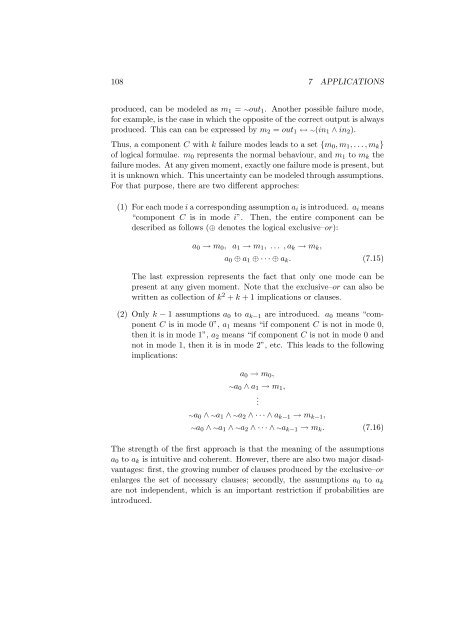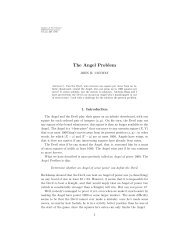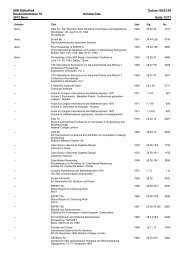Propositional Argumentation Systems and Symbolic Evidence Theory
Propositional Argumentation Systems and Symbolic Evidence Theory
Propositional Argumentation Systems and Symbolic Evidence Theory
You also want an ePaper? Increase the reach of your titles
YUMPU automatically turns print PDFs into web optimized ePapers that Google loves.
108 7 APPLICATIONS<br />
produced, can be modeled as m 1 = ∼out 1 . Another possible failure mode,<br />
for example, is the case in which the opposite of the correct output is always<br />
produced. This can can be expressed by m 2 = out 1 ↔ ∼(in 1 ∧ in 2 ).<br />
Thus, a component C with k failure modes leads to a set {m 0 , m 1 , . . . , m k }<br />
of logical formulae. m 0 represents the normal behaviour, <strong>and</strong> m 1 to m k the<br />
failure modes. At any given moment, exactly one failure mode is present, but<br />
it is unknown which. This uncertainty can be modeled through assumptions.<br />
For that purpose, there are two different approches:<br />
(1) For each mode i a corresponding assumption a i is introduced. a i means<br />
“component C is in mode i”. Then, the entire component can be<br />
described as follows (⊕ denotes the logical exclusive–or):<br />
a 0 → m 0 , a 1 → m 1 , . . . , a k → m k ,<br />
a 0 ⊕ a 1 ⊕ · · · ⊕ a k . (7.15)<br />
The last expression represents the fact that only one mode can be<br />
present at any given moment. Note that the exclusive–or can also be<br />
written as collection of k 2 + k + 1 implications or clauses.<br />
(2) Only k − 1 assumptions a 0 to a k−1 are introduced. a 0 means “component<br />
C is in mode 0”, a 1 means “if component C is not in mode 0,<br />
then it is in mode 1”, a 2 means “if component C is not in mode 0 <strong>and</strong><br />
not in mode 1, then it is in mode 2”, etc. This leads to the following<br />
implications:<br />
a 0 → m 0 ,<br />
∼a 0 ∧ a 1 → m 1 ,<br />
.<br />
∼a 0 ∧ ∼a 1 ∧ ∼a 2 ∧ · · · ∧ a k−1 → m k−1 ,<br />
∼a 0 ∧ ∼a 1 ∧ ∼a 2 ∧ · · · ∧ ∼a k−1 → m k . (7.16)<br />
The strength of the first approach is that the meaning of the assumptions<br />
a 0 to a k is intuitive <strong>and</strong> coherent. However, there are also two major disadvantages:<br />
first, the growing number of clauses produced by the exclusive–or<br />
enlarges the set of necessary clauses; secondly, the assumptions a 0 to a k<br />
are not independent, which is an important restriction if probabilities are<br />
introduced.








